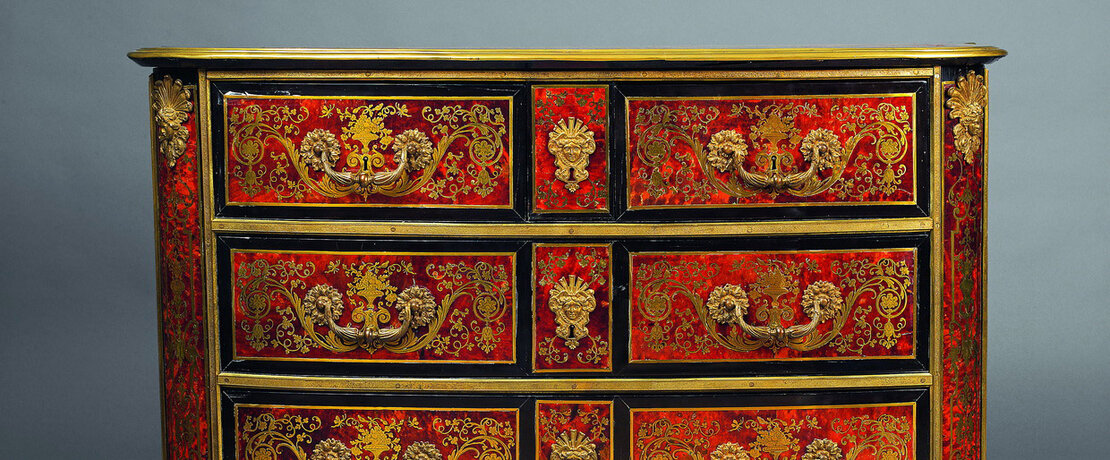18th Century Furniture at the top
The Decorative Arts auction on 17 November will be opened with the Jewellery sale and on 18 November continues with silver, porcelain, faience, furniture, glass and ceramics. Highlights of the auction will once again feature in a separate catalogue. Top lots of the sale include a Louis XIV commode and a Regency régulateur.

One highlight of the auction is a Louis XIV commode in unusually good condition featuring Boulle marquetry in bright red Première partie. It corresponds to a furniture type also produced by Nicolas Sageot (lot 949, 60/80,000). A large figurative tableau depicting a scene from the life of St. Benedict is also in the same technique and probably made in South Germany or the alpine countries in the mid-18th century. Magnificently decorated in tortoise shell, mother of pearl and coloured inlays, it was probably made for an altar or antependium (lot 948, 40/60,000). An important régulateur and baromètre from the Regency period, signed Samuel Gautier à Paris, made in the second quarter of the 18th century is executed in amaranth and rosewood veneer on oak as well as bronze and brass and has a height of 200 cm (lot 957, 40/60,000). With an estimate of 80/100,000, a magnificent baroque cabinet from Frankfurt and completed after 1772 is attributed to the Master Schilling (lot 959). An important white-glazed, polychrome painted majolica platter from Siena or Urbino around 1520 – 1530, measures 34 cm in diameter and is estimated at 30/50.,000 (lot 915).
Also of importance is a small collection of beautiful classicist porcelain tableware. The objects are from a Westphalian private ownership and were primarily brought together by the Cologne art dealer Hans Mischell who died many years ago. After the great success in the spring, the second part of the faience collection of Dr. Erwin Lukas will now be brought to auction featuring museum-quality pieces of Hanau, Delft or south German manufacture. A rich offering of Kunstkammer objects can be found in the catalogue 'Ausgewählte Objekte' ('Selected Objects') including gothic panels and important Limoges enamels. Particularly noteworthy is an early reliquary, once in the List collection. The auction also features a large number of textiles, old carpets and tapestries, among which can be found a 285 x 552 cm tapestry made in Brussels at the beginning of the 18th century featuring the continents of Europe and Asia (lot 957, 30/40,000).
SILVER
The usual broad collection of silver again offers a high quality selection of objects from the 16th to 20th century. One lot which stands out is a Reval communion jug for Baron von der Pahlen, made by Peter Polack in 1678 (lot 934, 20/24,000), as well as partly gilt, 197-piece Fabergé cased silver cutlery service made in Moscow in 1896 – 1908 (lot 982, 75/90,000).
A novelty goblet made in 1629 by the Master Gerrit Valck in Amsterdam features a small gilt snail sitting in the well. Novelty vessels such as this were extremely popular on the tables of the 16th and 17th centuries. Trick elements would hamper the drinker in emptying the vessel for example, or they would be frightened by the hidden 'surprise' at the bottom of the cup (lot 926, 12/15,000). A large lidded terrine with a présentoir made by Christian von Hausen in Danzig around 1760 – 1764 is estimated at 40/50,000, whilst a pair of Ulm gilt silver reliefs by the Master Hans Georg Bauhoff from the third quarter 17th century depict scenes from the life of King Davis after paintings by Rubens, estimated at 13/16,000 (lot 923).
JEWELLERY
As a result of the great success, the now regular separate jewellery catalogue this time offers 274 lots presented in chronological order from Roman gems to contemporary goldsmithing. The historical jewellery which dominates the work of the 19th century includes stonework such as a gold enamel brooch with a fine-cut agate cameo from the Italian glyptic Amastini family (lot 35, 2,200/2,500). Amongst the micro-mosaics worth highlighting are a fine, small plaque with a view of the ruins of Paestum (lot 20, 4/6,000), as well as an etui with a Neoclassical micro-mosaic garniture showing Putti as allegories of the four seasons (lot 19, 10/15,000).
Top lots among the diamond jewels are a Ducal bracelet covered with diamonds in various historical cuts (lot 59, 10/15,000), and a Belle Époque necklace with a laurel pattern complete with approximately 25 ct. worth of diamonds (lot 93, 20/25,000). Traditionally one chapter of the catalogue is devoted to artists' jewellery, in particular the Cologne workshop, including numerous granular pieces such as a beaded necklace and a pair of earrings individually ornamentally decorated by Rolf Goldschmitt (lot 145, 10/15,000). A special section is dedicated to original jewels by the Swiss goldsmith Albert Gilbert, who expertly combines precious stones with organic materials such as beetles, minerals and pearls, such as the present clip brooch with coral branches and moldavite (lot 173, 4/6,000). Highlights of the contemporary jewels feature works by the Swiss goldsmiths Paul Binder and Henri Weber with exceptional opals (lot 261/262, 6/8,000, 8/12,000).
The English miniaturist John Smart is present with a very beautiful female portrait, painted during his sojourn in India in 1787 (lot 121, 6/8,000).
